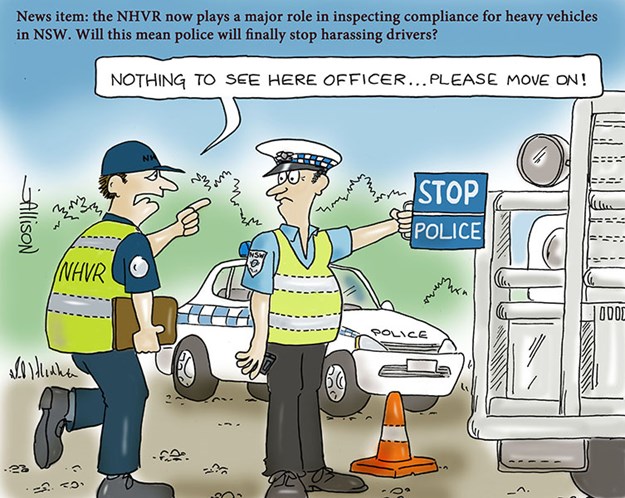OPINION: Switching to an electronic work diary can offer less opportunity for NSW Police to issue an infringement
The country is starting to open up again, as they tell us. Recently we attended the Casino Truck Show, the first since COVID-19 restrictions began. We shared a stand with the guys from THS Logmaster. They have affiliated with us in promoting and supporting their excellent electronic work diary (EWD), which has just been approved for use by the National Heavy Vehicle Regulator (NHVR). Glynn and Craig from THS Logmaster also provide compliance training and auditing services to the heavy vehicle industry.
We mention this for another reason also. Highway Advocates handles all heavy vehicle and traffic matters. However, we are becoming increasingly focused on fatigue offences. We have spoken about police enforcement on numerous occasions previously. There is no point in labouring the point here again.
The NHVR has spread its wings since the last edition – operating in New South Wales since the start of August. We have noticed changes in how things are done since that date. We have seen the NHVR applying for Supervised Intervention Orders (SIO) for first-time fatigue offenders, describing them as “systemic and persistent offenders”.
We have also experienced examples in South Australia whereby the regulator offers the opportunity for individual fatigue offences to be dealt with by an ‘Enforceable Undertaking’. We see this as a positive step. We are not so sure about the SIO idea, though. We believe it should be reserved for “systemic and persistent offenders”. Not first-time offenders who have, in most cases, simply started work too early after a major rest break.
RELATED ARTICLE: Little discretion shown as police continue to overcharge
Where are we going with all this, you may ask? We have been operating for almost 18 months and have represented many clients charged with multiple fatigue offences. The outcomes we have achieved are unheralded. However, they do not come easy.
The EWD is one key factor we believe is crucial in achieving these favourable outcomes. Another important ingredient is the personal story. This personal story is what changes you from an extension of a machine to a natural person with hopes and dreams.
Diary confiscation
Most of you who know me will know that I am not a fan of the surveillance culture. That culture is one of the main reasons we now promote using EWDs. If you fudge or make a mistake in your work diary, you may face fines of over $17,000 and four points for each occasion. If you do the same and have an accident or worse, your travel times will be investigated with forensic depth. The level of surveillance watching your every move is staggering. If the worst happens, you will be looking at serious jail time.
Why expose yourself to the risk of potentially massive fines or worse? Many clients come to us with multiple breaches, which are nearly always police matters. Police load up single court attendance notices with as many sequences or counts as possible. We have also noticed a disturbing trend with NSW Police confiscating complete work diaries on the side of the road. Never mind the pink copies, they take the whole kit and caboodle.
The only way in which we can advocate for leniency is to give a little. When we are approached by clients facing multiple sequences, we know one thing for sure. We give the court an offender who has ameliorated (look that up) their offences and is unlikely to re-offend. This is also known as taking responsibility for your actions. Why be responsible for putting thousands of dollars towards respective state government budgets?
Someone very wise told me not long ago: “If you can’t beat ’em, join them.” Well, I did that, and now we are doing it again. This is why we have teamed up with the guys from THS Logmaster.
Many of our clients have experienced remarkable outcomes when we combine our knowledge and experience with the technology advantage of an EWD.
Multiple penalty notices
Segueing now to state governments again, this particular brickbat is reserved for NSW. Not the courts, who have nothing to do with this. It is the executive who is responsible in this instance. When we achieve one of these remarkable outcomes, it is usually ordered as a conditional release order for a certain period (six months up to two years). The standard conditions provide that you must not be brought back before the court for any other matter during that period. If you are, the court may convict and penalise you for the offences that brought about the order in the first place.
However, they are still dismissed upon a finding of guilt. The difference between a section 10(1)(a) or a 10(1)(b) is the conditional release order or good behaviour period attached to it. Get the 10(1)(a) and no court costs. Get the 10(1)(b), and it is $165 for every sequence. If you get 20 sequences dismissed, you are still looking to have to pay over $3,000 for victim impact and court cost levies.
However, there is only one court attendance notice, which is another reason why we think it wrong to load up a single notice with multiple counts or sequences. We often find that police will do that and issue multiple penalty notices also. Talk about the gift that keeps giving.
If you get one of these, we know what to do.
*ROBERT BELL, a former truck driver and current law undergraduate and practising paralegal, is the CEO and a director of Highway Advocates Pty Ltd. Contact Highway Advocates Pty Ltd on robert.bell@highwayadvocates.com.au
or phone 0488 010 101.




